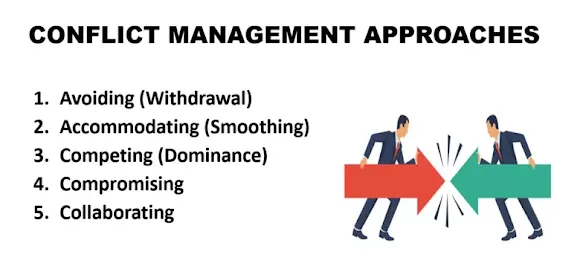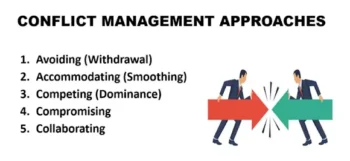Table of Contents:-
- Conflict Management Meaning
- Conflict Management Approaches
- Conflict Meaning
- Conflict Definition
Conflict Management Meaning
Meaning of Conflict Management – Conflict management is the procedure of planning to avoid conflict where possible and the process of organising to resolve conflict where it does happen, as smoothly and rapidly as possible.
Conflict resolution is the principle that all conflicts cannot necessarily be resolved, but learning how to manage conflicts can decrease the odds of nonproductive escalation.
Conflict resolution involves acquiring skills related to conflict resolution, self-awareness about conflict modes, conflict communication skills, and establishing a structure for the management of conflict.
In many circumstances, effective conflict resolution skills can make the difference between positive and negative results.
Related article: System Approach to HRM
Conflict expert Kenneth Thomas notes that several basic reactions can be thought of as styles, strategies or intentions for dealing with conflict.
These approaches to managing conflict are a function of both how assertive one is in trying to satisfy one’s own or one’s group’s concerns and also how cooperative one is in trying to satisfy those of the other party or group.
Conflict Management Approaches
Various approaches are as follows:

1) Avoiding (Withdrawal)
The avoiding style is characterised by low assertiveness of one’s interests and low cooperation with the other party. Avoidance can provide some short-term stress reduction from the rigours of conflict it does not change the situation.
Advantages of Avoiding
The advantages of avoiding strategy are as follows:
i) The most important advantage of this strategy is that no conflicts arise between parties, as no one addresses the problems.
ii) Can put the other side under pressure.
iii) Forces the other side to take the initiative.
iv) Can buy time.
Disadvantages of Avoiding
The disadvantages of avoiding strategy are as follows:
i) The most important disadvantage to this strategy is that the problems persist and can get worse over time. Individuals of higher authority may take over and solve the problem with solutions that benefit no parties.
ii) Can give control to the other side.
iii) At its extreme, it may be unethical.
2) Accommodating (Smoothing)
This style is low in assertiveness and high in cooperativeness. Parties are cooperative, accommodative, and prepared to make reasonable sacrifices to fix the conflict. The emphasis is on the common interest of the conflicting groups and the de-emphasis on their differences. This technique can be used with a temporary solution that is needed in the short run.
Advantages of Accommodating
The advantages of accommodating strategy are as follows:
i) It maximizes empathy and minimizes assertiveness.
ii) The advantage of accommodation is that conflict is quickly resolved, which helps with short-term goals.
iii) Accommodating strategy helps to maintain good relationships and receive personal acceptance.
iv) It also tries to ignore conflict in an attempt to keep everyone happy.
Disadvantages of Accommodating
The disadvantages of the accommodating strategy are as follows:
i) Accommodation can lead to a lack of self-esteem within the accommodating party. The winning party may also begin to take advantage.
ii) The accommodating party may end up sacrificing a principle that hampers meeting the long-term goal.
iii) Another disadvantage of accommodating people during negotiation is that one size doesn’t get their point across, and problems affecting them continue.
3) Competing (Dominance)
A competing style tends to maximise assertiveness for one’s position and minimise cooperative responses. In doing so one tends to frame the conflict in strict win-lose terms. Full priority is given to one’s own goals, facts or procedures. The competing style holds promise when someone has a lot of power and you don’t have to interact with the other party in the future.
Advantages of Competing
The following are the advantages of competing strategies:
i) Helpful in Very Simple Cases: It can be useful when there is only one issue to deal with.
ii) Intimidating: It can result in a beneficial outcome if there is a real power imbalance and one party is very easily intimidated.
iii) Effective: It can be effective when used sparingly, particularly at the beginning of a negotiation.
Disadvantages of Competing
The following are the disadvantages of competing strategies:
i) Non-Creative: This strategy can lead to simple bargaining over one and does not encourage creative solutions.
ii) Stalemate is Possible: If a level is reached below which a negotiator cannot go, being less creative can mean that the negotiation fails as the parties cannot come together. The result can also be in breaking down long-term relationships.
iii) Unrealistic: It is very unusual for there really to be only one issue in a negotiation. There may be more than one relevant issue, but this strategy forces concentration on a single item.
iv) Difficult to Sustain: It can be very difficult to use this strategy if it goes against the negotiator’s personality type. If the negotiator’s personality is quiet and very accommodating by nature, it might be very difficult to act competitively.
v) Unexpected Reaction: It is hard to predict the outcome of the competitive approach or control the process. It may be possible that the opponent might not react in the same way as the other party want. They may carry on being reasonable, or start being as competitive as you are instead of backing down. If this happens, you will not get the results you were hoping for.
4) Compromising
Compromise combines immediate levels of assertiveness and cooperation. Therefore, it is itself a compromise between pure accommodation and pure competition. Compromise is not so useful for resolving conflicts that originate from power asymmetry, because the weaker group may have less to offer the stronger group. It is a good fallback position if other techniques fail.
Advantages of Compromising
The advantages of the compromising strategy are as follows:
i) People who use compromise tend to see others as worthy and equal to them and hence seek fair play. They realise that nobody can get everything they want and seek an equitable arrangement.
As with yielders, they care about what other people think about them but have higher self-esteem and see themselves as similar to others rather than inferior.
ii) The advantage of a compromising strategy is that everybody agrees to do their part to solve the conflict.
iii) The outcome can generally be seen as “fair” to both parties because each gets something in return.
iv) This can also solve a short-term conflict while laying the foundation for resolving a long-term problem.
Disadvantages of Compromising
The disadvantages of a compromising strategy are as follows:
i) The disadvantage of a compromise is that neither party leaves the negotiating table completely happy.
ii) Since compromises are short-term, they usually indicate that another conflict will occur in the future.
iii) Besides seceding personal ambitions, compromising may not work at all if the demands are too great for any or all parties to agree.
iv) While the final solution typically has the approval of all concerned, it does not give clear and optimal results for complex problems.
It can be used to achieve a temporary solution quickly while a more permanent solution is being considered and prepared.
5) Collaborating
In the collaborating mode, both assertiveness and cooperation are maximised in the hope that an integrative agreement occurs that fully satisfies the interests of both parties. It probably works nicely when the conflict is not intense and when each party has information that is helpful to the other.
Effective collaboration can take time and practice to develop, it continually enhances achievement and productivity. Collaboration also helps to manage conflict within the organisation.
Advantages of Collaborating
The advantages of collaborating strategy are as follows:
i) Stalemate is Less Likely: It is because concessions can be made, and a deadlock is rarer.
ii) Continued Relationship is Likely: It is because this strategy is not aggressive, it is usual to be able to continue a relationship after the negotiation.
iii) Less Stressful: This sort of encounter is less stressful and both parties will probably feel they have been fairly treated.
iv) Focus on Main Issues: This approach makes it easier to focus on the important issues,
v) Creative: In this approach, both sides are encouraged to come up with creative options, therefore it is more likely that a solution that is effective for both sides will be found.
Disadvantages of collaborating
The disadvantages of collaborating strategy are as follows:
i) Needs an Opponent with a Common Strategy: If the other side will not use this strategy and refuses to give concessions, the party using this strategy may give too much away.
ii) Finite Amount of Concessions: If concessions are given too easily, you could find that you are left with nothing else to give before the negotiation has ended.
iii) Weak: An opponent with another strategy might see this approach as weak. It could encourage competitive behaviour.
iv) Vulnerable: Others may take advantage if you use this approach. It is vital to check to see if it is working and that you are getting as many concessions as you are giving.
This problem can be mitigated by making your concession offers conditional, or first indicating a willingness to be flexible to gauge the reaction before making specific concessional offers.
v) Can give too Much: If you are too concerned with getting any form of agreement, you might find that you have not got as good a deal for your client as you might have using a more competitive style.
Conflict Meaning
Conflict can be defined in many ways and can be considered as an expression of hostility, negative attitude aggression, rivalry and misunderstanding. It is a disagreement by individuals or groups within the organisation that can centre on factors ranging from resource allocation and divisions of responsibility to the overall direction of the organisation.
The domain of work and organisation constitutes an arena in which diverging aims and interests provide inexhaustible sources of conflict at local, national and international levels.
Conflict may occur between various organisations or within the organisations, or between organisations and their political and social environments.
Related Article:- Importance of Organisational Behaviour
A process that begins when one group perceives that another group has been negatively affected, or is about to negatively affect something that the first group cares about.
Conflict Definition
According to Joe Kelly, “Conflict is defined as opposition or dispute between persons, groups or ideas”.
According to Follett, “Conflict is the appearance of difference, a difference of opinions of interests”.
Peterson states that – “Conflict is defined as an interpersonal process that occurs whenever the actions of or person interfere with the actions of another”.
According to Stephen Robbins, “Conflict is a process in which efforts are purposefully made by a person, unit, or group to block others that results in frustration either in attaining goals or furthering his/her interests”.
You May Also Like:-
Nature of Organisational Behaviour
Conceptual Foundation of Organisational Behaviour
Contributing Disciplines to organisational behaviour
Models of Organisational Behaviour
Approaches of Organisational Behaviour
Emotional Intelligence in Organisational behaviour
Factors Influencing Perception
Scope of Organisational Behaviour
Importance of Organisational Behaviour
Challenges and Opportunities of Organisational Behaviour
Factors affecting group behaviour
Causes of Conflict in an Organisation
Types of Conflict in an Organisation
Organisational Development Process
Factors Affecting Organisational Culture
Trait Theory: Stogdill’s trait factors
